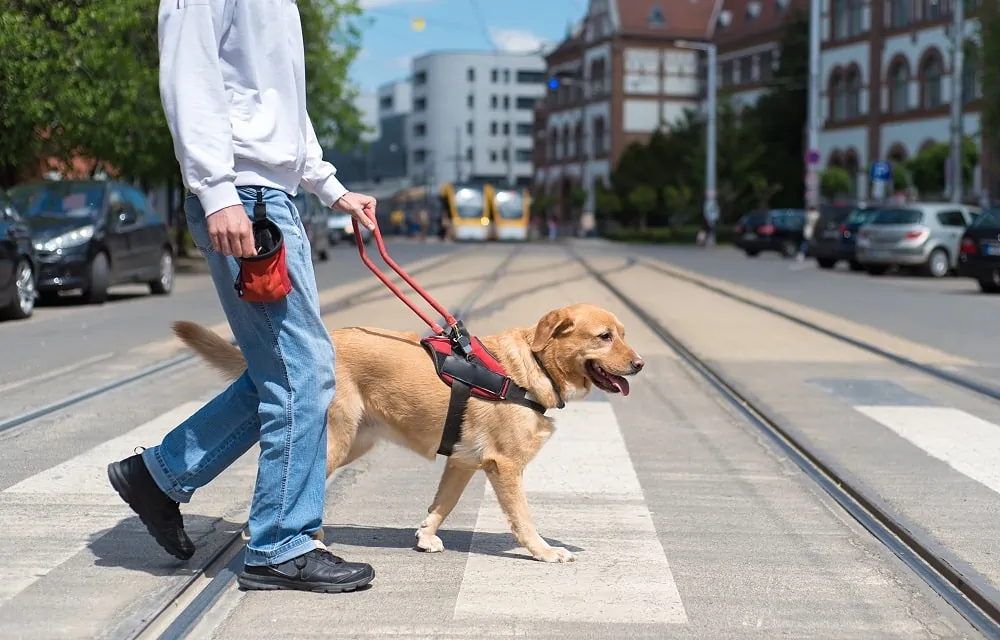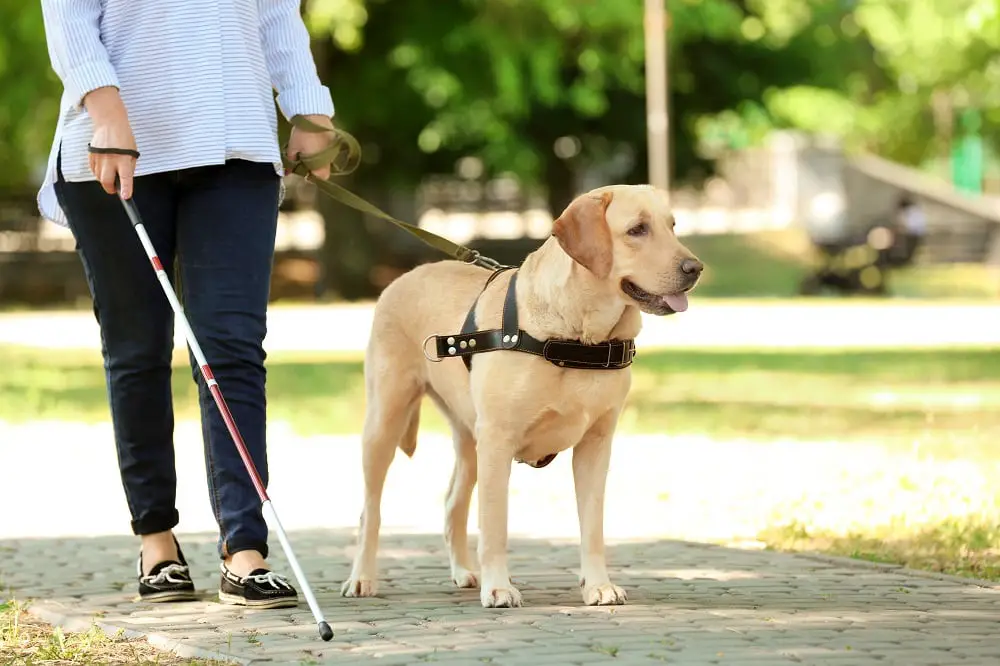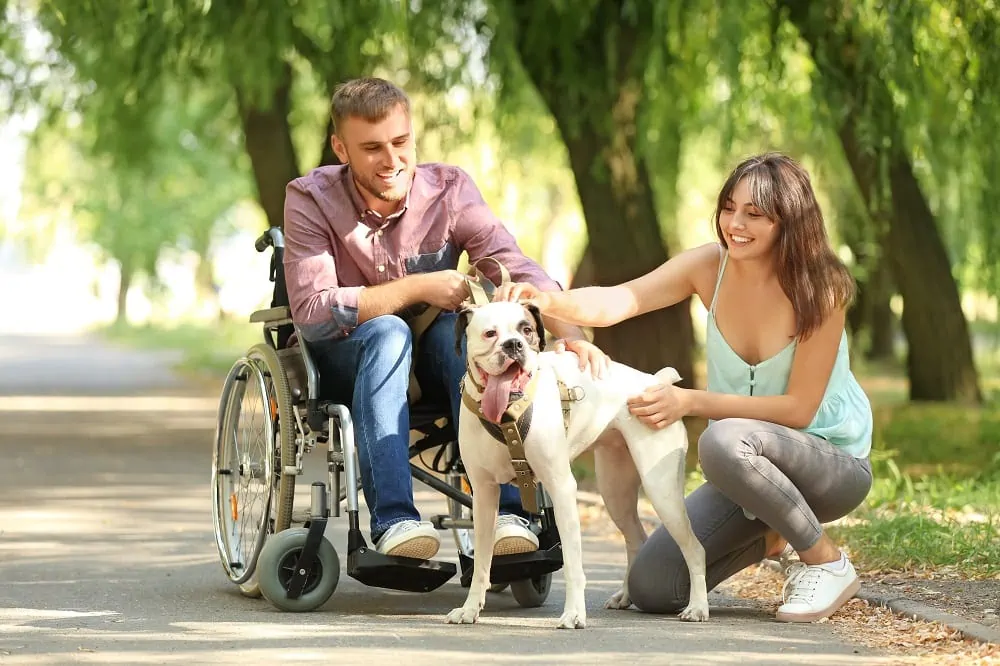For many people, reaching out to ask for help when facing visible or invisible disabilities is the most challenging thing in the world. A feeling of hopelessness, and helplessness, is part of the dilemma, not to mention the shame that is inevitably linked to requiring assistance.
Do I qualify for a Service Dog? To determine if you qualify for a service dog assess whether you meet any of the following criteria; diagnosed with a physical, mental disability, or chronic illness. The criteria for each of these categories are stringent. Understand that qualifying as disabled and being assigned a trained service dog is a complicated decision bisected by federal law and medicine, and decidedly not on simply wanting one.
A major stumbling block to acquiring one is mainly the mass confusion about what constitutes a service dog and what doesn’t, potentially resulting in refusal of entry to private places, denied housing, and oftentimes being publicly embarrassed.
Differences Between a Service Dog and an Emotional Support Animal
Service Dog
A service dog is an animal trained to perform a particular task for a qualifying disabled person. While a medical doctor may write a note recommending a service animal, one is not legally required (source).
Different Kinds of Service Dog Training
Physically Challenged Training
The most common type of service dog does for a physically challenged person what they have difficulty doing for themselves:
- guiding their visually impaired handler
- retrieving items dropped by their handler
- opening doors for a handler in a wheelchair or who is walking with assistance
- being a hearing-impaired person’s ears to hear doorbells, ringing phones, and smoke alarms
- alerting the handler to any drops in blood sugars or of an oncoming seizure
- looking for and bringing help if the handler is in an emergency situation
- physically aiding the handler if they are having a seizure or other health complications
Psychiatric Training
Some Service Dogs are trained to assist people who suffer from mental illness including severe anxiety and PTSD. They can help in various ways:
- looking for and bringing help in case the handling is in hiding out of fear
- helping to guide their assigned handler home after a dissociative episode
- finding a person or safe place (like an exit) if the handler is having a panic attack and cannot call out for help
- signaling the handler when hearing certain sounds like a smoke alarm in the case of the handler being heavily medicated
- fetching medication in case of an emergency
- doing a complete search of the house or building for the handler who suffers from PTSD and hypervigilance syndrome
Emotional Support Animal
An emotional support animal does not perform specific tasks but can be used as support by someone who is suffering either emotionally or mentally. A person would be required to undergo an evaluation by a trained medical professional who must write a note describing their needs.
An emotional support animal is used as part of a medical treatment plan to provide companionship, relieve loneliness, and occasionally help with depression, anxiety, and certain phobias.
Therapy Dog
Therapy dogs provide many people with soothing therapeutic contact. This therapy usually occurs within a clinical setting. Therapy animals can be used among young and old patients to improve physical, social, emotional, and/or cognitive functioning.
It must be noted that emotional support animals, comfort dogs, and therapy pets are not granted the same levels of access as service dogs under section II and III of the Americans with Disabilities Act or ADA (source).
A tabled comparison between the 3 types of Service Dogs available:
| Comparison | Service Dog | Therapy Dog | Emotional Support Dog |
| Right to bring the animal into all public establishments (ADA) | ✔ | ❌ | ❌ |
| Needs to be able to handle a variety of experiences | ✔ | ✔ | ❌ |
| May live with a disabled handler even in places with a “No Pets” policy | ✔ | ❌ | ✔ |
| May fly inside an airplane with a disabled handler | ✔ | ❌ | ✔ |
| Provides emotional support mainly through companionship | ❌ | ❌ | ✔ |
| Trained to assist only one person | ✔ | ❌ | ❌ |
| Provides support to many people | ❌ | ✔ | ❌ |
Requirements to Qualify for a Service Dog
Applying and actually qualifying for a service dog under titles II and III of the Americans with Disabilities Act (ADA) is quite a complicated process and dependent on many related and unrelated factors (source).
First of all, only people who qualify as disabled under the ADA can actually get a service dog, and that’s only if it is possible to train a dog to do for you what you cannot do for yourself. Transient or temporary disabilities such as a broken arm do not count.
If you have a disability, whether physical or mental, that severely restricts you from being able to perform any major life activities, you could qualify for a service dog provided a dog can be trained to do this task for you instead.
Examples of Service Dogs

The ADA has strict criteria on what is or is not a service animal. The following examples give an idea of what service dogs are all about:
Guide Dog
Acts as the sight of a person who has severe visual impairments or is clinically blind to give them the opportunity to safely maneuver through the world.
Hearing or Signal Dog
Acts as the ears for a person who is deaf or has significant hearing loss when a sound occurs, such as a fire alarm, or a knock on the door.
Psychiatric Service Dog
Acts as a signaler for people who suffer from psychiatric episodes and is trained to warn them before the onset of an episode.
For PTSD sufferers, the dog might also be trained to perform specific functions like checking the house for intruders, turning on the lights, and reminding the handler to take medication.
For people with dissociative disorders, the dog might be trained to prevent self-mutilation or other dangerous situations.
SSigDOG
Acts as a signaler for a person with autism by alerting them of distracting repetitive movements.
Seizure Response Dog
Might be trained to either stand and watch during an episode when a person suffers from seizures, or to go for help. Some of these dogs have been trained to predict when a seizure may occur and get the person to sit down or guide them to a safer place.
From the examples above, it can clearly be seen that the role of a service dog is not to provide comfort or familiarity but to do specific tasks that allow their human handlers to continue living their best lives with the least amount of stress.
It’s also noticeable that none of these dogs are chosen to act as friends and companions to their handlers. These specialized dogs are trained from puppyhood to perform these tasks professionally and without fault and are then paired with the most suitable handler in need.
Common Misconceptions About Service Dogs

Service Dogs are Breed Specific
Any dog can be trained as a service dog, provided it has the right temperament, and no dogs are excluded by virtue of their breed.
Certification is Mandatory
There is no certification authority that one has to apply to after receiving or training a service dog, and mail-order certificates are not recognized by the ADA or the Department of Justice.
Service Dogs Must Wear Reflective Vests
There is no law that states a service dog must wear a special uniform to advertise it is on the job although a vest might be useful when entering places like airports and restaurants.
All Working Dogs are Service Dogs
All service dogs are working dogs, but not all working dogs are service dogs; for example, police dogs are trained to do a specific task, but it is not helping a disabled policeman.
All Pet Dogs are Service Dogs
A pet whose mere presence provides comfort to its owner suffering from an anxiety attack would not be a service dog unless the “pet” was trained to detect attacks and preempt them.
Training Service Dogs is Simple
Training can take anywhere from six months to two years and ideally starts with a puppy that displays the necessary temperament. Ongoing training occurs throughout the animal’s life.
If you still find it difficult to understand what is a service dog, check the video below:
Responsibilities of the Handler
The complete care of a service dog falls squarely on the handler. Whether the dog has been self-trained or paired with the handler through a professional agency, the human is considered as the caregiver in the partnership and is expected to feed, groom, and maintain the animal.
It is the handler’s responsibility to ensure that the service dog is licensed and registered according to the laws of the city he resides in. The dog must also receive all necessary shots at a veterinarian.
The ADA requires service dogs to be on a leash at all times unless tethering restricts the dog’s movement such that the required task is unable to be completed. In these circumstances, the handler should be able to control the animal using his voice, a clicker, or some other means.
If the dog behaves in a questionable manner, barking incessantly, jumping on people, being disruptive, while in any place, the handler can be asked to vacate the premises. The handler will be held liable for any consequences resulting from the dog’s actions, including breakages.
Your Rights as a Service Dog Handler

Public Facilities and Venues
A service dog may not be denied access to any place that other members of the public are allowed to go into, including places with a “No Pets” policy, including hospitals, restaurants, and bars.
A person entering a place with a service dog should be prepared to answer only two questions regarding the animal, mainly whether the person is disabled, not what the disability is, and what task the animal performs for the handler.
These questions should only be asked if the person’s disability and the dog’s purpose are not plainly visible, for example, a guide dog assisting a visually impaired person or a dog opening doors for a person in a wheelchair.
A handler is not legally required to carry any documentation or doctor’s note regarding their disability nor papers proving the training, certification, and licensing of the dog when going to any venue.
Furthermore, having a service dog cannot attract a surcharge in places that charge extra for bringing pets. In such places, the handler and the dog are treated as a single entity and must be charged accordingly.
Educational Facilities
The ADA permits any public school student (K – 12) with a disability who requires the use of a service dog to have that animal at school with them. The ADA stipulation is only for service animals and not therapy or emotional support animals.
Under the ADA, universities, and colleges are also expected to allow service dogs access to all venues and places that the handler is allowed into. These higher education facilities may not request documentation except those relating to inoculations.
Colleges and other governmental entities may offer voluntary registries for service dogs to ensure that staff is aware to search for service animals and their handlers during any emergency evacuation.
Housing
A disabled person is automatically protected by the Fair Housing Act against discrimination with regard to acquiring housing for himself, his family, and a service dog. The “No Pets” rule does not refer to service dogs; thus the animal cannot be used as a reason why housing is denied.
A landlord or homeowner’s association is, however, well within their rights to request documentation if the handler requests reasonable accommodations, but where the ADA applies, requesting this type of paperwork could be deemed illegal (source).
Employment
An employer may request documentation to determine if the dog provides any support to the handler in a work environment. A service dog may be excluded from any environment where safety is a concern, but may not be disallowed on the grounds of allergies or fear.
Transportation
A person traveling with a service dog cannot be denied transportation from public or private companies, cannot be charged a surcharge for the dog, cannot be excluded from certain seats, or be forced to sit in a particular spot, as per the law.
As per the Air Carrier Access Act (ACAA), airlines may not refuse or exclude a passenger from traveling with them solely due to their having a service dog. An airline is not obligated to upgrade you to a different class of service to accommodate your service animal (source).
An air carrier is allowed to request proof that the animal is a service dog in the event that the disability and the dog’s purpose is not plainly visible. The airline may request identification cards, documentation, or ask basic questions to gather proof.
If you are traveling out of the country, seek the necessary permission before bringing your animal into a foreign country that may not accept service animals. Failing to do so might see your dog end up in quarantine.
Exclusion of Service Dogs

Dangerous Interaction
Your service dog may be excluded from some public areas for a few reasons, including but not limited to places where your dog’s presence may affect or alter a project or event in some way, for example, at a zoo where the contained animals may react violently to the dog’s presence.
Dog Allergies
Some boarding schools may have entire dormitories that are off-limits to service dogs and other animals, as they house children who are known to be dangerously allergic to pet dander or even flea bites.
Disruptive Dogs
A disruptive service dog that is misbehaving and out of control may be required to wait outside an establishment for its handler if staff feel that the situation is not being handled adequately and no alternative solution can be found. For solutions on how to train dogs to be more disciplined, check this article out.
Multiple Dogs
Similarly, where a handler has two or more service dogs where each provides different or multiple functions, the establishment may require that only one dog come in and the rest remain outside due to necessity and space constraints.
Unattended Dogs
Hotel guests are not allowed to leave service dogs in their rooms unattended while making use of the facilities. Handlers may be asked to vacate the hotel should they be found guilty of this practice.
Public Health Code Violations
Service dogs may not be served at the table in a restaurant, may not use a public swimming pool, may not be taken inside religious institutions, and, most importantly, may not override or violate any public health rules in place.
Final Thoughts
As you can see, there are many types of dogs in service, but training and handling a service dog, while it is obviously meant to make life as easy as possible for a disabled person battling either physically or mentally, involves a lot of challenges as well.
Service dogs are not pets or meant to provide hours of companionship for a lonely soul, but they can certainly help a lot of people overcome debilitating limitations so that they are able to enjoy the world again.
If you do qualify for a service dog, make sure to do your homework and weigh up all the pros and cons first and then contact ADA on 800-514-0301 (Voice) and 800-514-0383 (TTY) to speak with a Specialist about any specific concerns you may have.


0 Comments